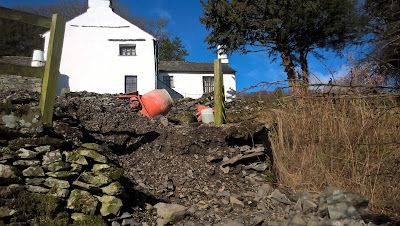If you've ever driven up from Windermere to Ambleside, you'll have passed the tallest tree in the northwest. You may even have noticed this grand fir, and other magnificent conifers, standing proud against the skyline.
 |
| The north-west's tallest tree |
These trees dwell in Skelghyll Woods, just south of Ambleside. It's an interesting example of Victorian-era conifer planting, at a time when new and exciting trees were coming back with plant hunters from north America and other places. Douglas fir, giant redwoods, grand and noble firs... to hear some of the tales of trees over 100m tall must have sounded fanciful, but even though they would never see their trees grow that tall, many landowners began planting these new seeds.
Even now, when we look at Skelghyll, we might only be seeing tree-teenagers. It's easy to think of these as mature 'tall trees', but given some of these species last for a thousand years or more in their native ranges, it's possible that even now we're not seeing them at their best.
 |
| The cathedral-like grove of Tall Trees |
Compare the ornamental planting of these new conifers, the excitement of interesting sounding trees, with later vast conifer planting for timber in what were previously natural oakwoods. If this was done now we could even consider it to be 'eco-crime', but at Skelghyll the trees reflect what was, back then, Victorian ideas of improvement. As much as we might resist such attempts now, it has undoubtably resulted in something rather special and unique at Skelghyll.
Although these conifers might live on for centuries more, they are mostly of a certain age with very few new trees growing. Because of this, we've recently planted a handful of new, exotic conifers in the woods. Dealing with trees that live for 200 years or more, not many need to be planted at any one time, but if in twenty years another ten are planted, and the same twenty years after that... well, you get the drift. The idea is to have a varied age range of conifers, the next generations coming through to ensure continued presence of cracking trees.
Last year we were very fortunate to get a kind donation that enabled us to buy four new trees and rolls of chestnut paling to guard them from hungry deer. The lovely couple that donated the trees, Mr & Mrs Vaughn, joined Area Ranger, James Archer, and Woodland Ranger, Liam Plummer, to plant them.
 |
Mr & Mrs Vaughn plant a Japanese umbrella pine
with Area Ranger James |
Thanks to this couple, we planted two American species - a grand fir, just like the tallest of the tall trees, and a Colorado blue spruce - and two east Asian species, a Japanese red cedar and a Japanese umbrella pine.
 |
| The couple plant a Grand fir with Woodland Ranger Liam |
We were also lucky to receive four other trees from the National Trust's Plant Conservation Centre - two Himalayan firs, a Himalayan yew and a Jurassic-looking Podocarpus. The Lake District's 'woody volunteers' were out in the sunshine to help plant these ones, again guarded by chestnut paling.
 |
| 'Woody Volunteers' Lynn and Alan plant the Podocarpus |
Add to this the three trees planted by the rangers last year, and you can begin to imagine the next generation of tall trees at this woodland. Whilst none of us will ever see them as impressive as their neighbours, it's a welcome thought to imagine just how they might look in a century or two. Even our current tall trees must have had equally small starts at one point!
 |
| Little and large! |















